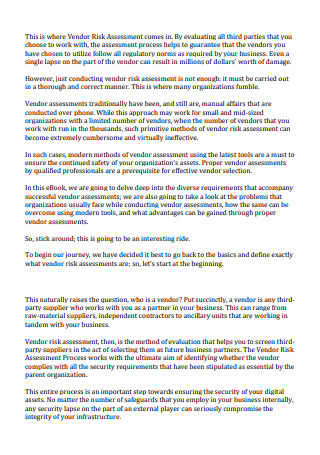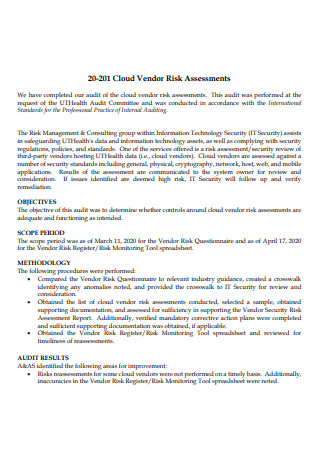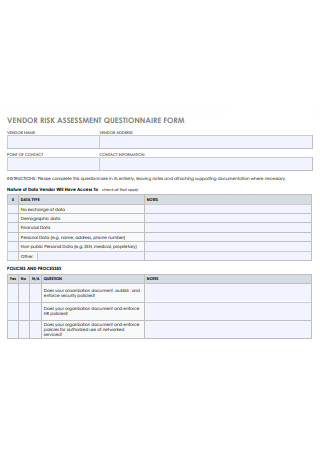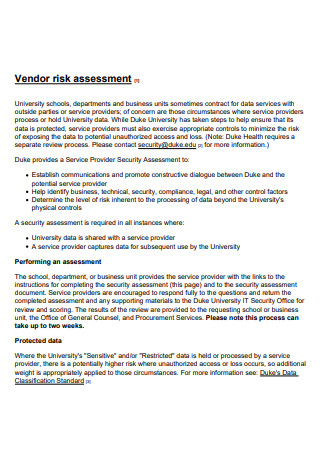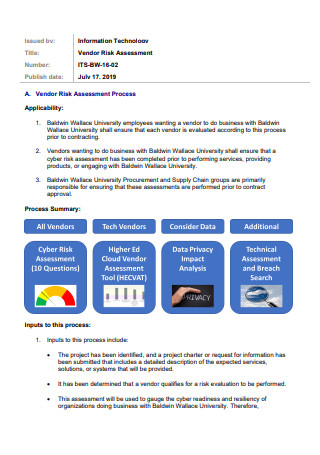4+ Sample Vendor Risk Assessment
FREE Vendor Risk Assessment s to Download
4+ Sample Vendor Risk Assessment
What Is a Vendor Risk Assessment?
Types of Vendor-Related Risks
Instances To Perform the Vendor Risk Assessment
How To Conduct a Vendor Risk Assessment For the Company
FAQs
What must the vendor risk assessment contain?
What is the purpose of having vendor risk assessments?
What is a vendor risk questionnaire?
Vendors also help with reducing costs by negotiating better and more practical prices for equipment and materials, providing discounts and incentives to increase the profit margin for many companies. Aside from these, establishing a positive relationship with vendors can help mitigate risks and protect the organization in the long run. For this reason, it is vital to create a vendor risk assessment when dealing and handling with vendors. What is a vendor risk assessment, and what are the advantages of constructing one for the company? The article provides valuable information to help leaders better understand the document, including its definition, types of vendor-related risks, when to perform a vendor risk assessment, and a guide to creating a comprehensive risk assessment document. A part of the article also tackles answers to frequently asked questions regarding the assessment report.
What Is a Vendor Risk Assessment?
A vendor risk assessment or VRA, also known as a vendor risk review, refers to the process of identifying and evaluating possible hazards and risks from third-party institutions like vendors concerning their operations and resources, along with the probable influence on the organization. These risk assessments are essential, especially if a vendor has the responsibility for vital business operations and functions, access to confidential information and client lists, or communicates with customers. When performing vendor risk assessments, the company determines possible outcomes of unpredictable scenarios. Upon defining these events, the next step is to identify, measure, and prioritize them. Different risks can happen when interacting with vendors, and these include the reliability and accuracy of financial, operational, and customer information. Risks involve security breaches, regulatory and statutory compliances, and efficiency and effectiveness of operations. Through procedures like due diligence and monitoring of vendors, there is a great chance for the organization to mitigate risks before they happen, providing a firm foundation for productive and positive relationships.
According to the report from IBISWorld regarding the street vendor market in the United States from 2002 to 2027, the market size of the street vendor industry, according to revenue, is approximately 2.4 billion US dollars in 2022. The growth rate of the street vendor industry can rise to 21.4 percent in 2022.
Types of Vendor-Related Risks
Knowing and identifying vendor risks allow the company to prepare and assess third-party risks with accuracy, ranking suppliers according to how they can be threats to an organization. Security teams then make the necessary assessments to produce remediation strategies to address identified risks and threats. When companies provide third-party access to their networks, they also permit access to classified and sensitive information, including company, employee, and customer profiles. There are different types of vendor-related risks, and the section below helps readers understand them better.
Instances To Perform the Vendor Risk Assessment
Performing vendor risk assessments must happen before engaging with vendors, during daily schedules and scheduled dates, or when red flags occur for them to uphold the standard operating procedures of the contract agreement. The section below provides information about the different instances in that companies can perform the vendor risk assessment.
How To Conduct a Vendor Risk Assessment For the Company
Before starting the risk assessment process, it is essential to set the company up for success. Ensure buy-in for the entire organization, including top executives, for the vendor risk assessment framework that it will use. Indicate the monitoring process, feedback review procedures, and pinpointing and managing of risks. Make sure to apply and utilize one risk criteria for all the vendors and adopt the appropriate measures according to the type of product and services the company outsources from vendors.
-
1. Catalog and Rank the Vendors
When a company does not have control over the procurement process and relationship with vendors and suppliers as they grow with the company, the vendor list continuously increases, becoming long, unruly, and disorganized. Organizing the list saves time and money and prevents possible complications. Take note of the roles and responsibilities of vendors in the organization, who owns the relationship between the vendor, which vendors can access confidential information, and whether they are responsible for vital business operations. Check the roster of vendors and evaluate whether their loss can have significant implications on the company and its customers. Take into consideration how long the company can recuperate from the loss.
-
2. Understand the Different Types of Risks, Tolerance, and Criteria
Take the time to look at the business and possible risks before assessing vendors. Consider the industry and all the external factors that can affect its operations and growth, such as economic cycles, market conditions, technological advancements, and supply costs. Identify the nature of operations, ownership and organizational structure, and the overall financial performance of the company. There are different types of risks when dealing with vendors aside from the ones mentioned above, including IT disruption and failures, fraud and theft, transaction, replacement, upstream, and downstream risks.
-
3. Identify Risk Tolerance and Rating Criteria
The first thing to do is to determine whether the vendor is upstream or downstream, then classify them according to their importance to the organization, and finally, develop a risk profile. Risk assessments tend to focus on questions with answers that apply to the vendor management risk matrix. For each answer, there is a corresponding point value to identify the level of risk. If the findings return unfavorable, but the vendor or supplier serves as an asset, make sure to work out to mitigate potential hazards.
-
4. Create a Profile for Key Vendors
Make sure to check reviews, feedback, and press releases from previous companies working with the vendor to check for credibility. It is also necessary to check the human resource, environmental, and incident security to validate compliance with business policy and procedures and other regulations. Use various methods to determine whether to continue dealing with vendors by categorizing the type of service they offer, their access to company information, the performance of due diligence, and on-site audits.
-
5. Compare and Contrast Top Vendors in the Industry
Perform research studies on vendors and create risk profiles for each one. Develop a profile that illustrates the perfect vendor for the company according to the current and future needs of the company and use this as the standard, preparing for future vendor RFPs.
FAQs
What must the vendor risk assessment contain?
The vendor risk assessment questions must include statements about references, performance, compliance, disaster preparedness, security procedures, cyberthreat governance, organizational structure, security control, and technology.
What is the purpose of having vendor risk assessments?
Conducting vendor risk assessments provide visibility to the risks that the company can induce when dealing with vendors.
What is a vendor risk questionnaire?
A vendor risk questionnaire is a document that helps the organization identify the possible weaknesses of vendors, partners, and suppliers that can lead to date breaches, data leaks, and other risks.
Companies must be vigilant when dealing with third-party companies, like vendors and suppliers, as they can directly affect daily business operations, as well as, the reputation of the organization. Companies must initiate background checks and gain more knowledge about their partnerships with vendors by conducting a vendor risk assessment. It guarantees that the company does not suffer drastically due to the performance of vendors. Develop and conduct a vendor risk assessment for the organization by downloading from the 4+ SAMPLE Vendor Risk Assessment in PDF, only at Sample.net.

